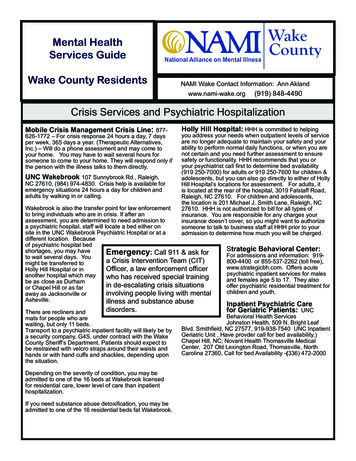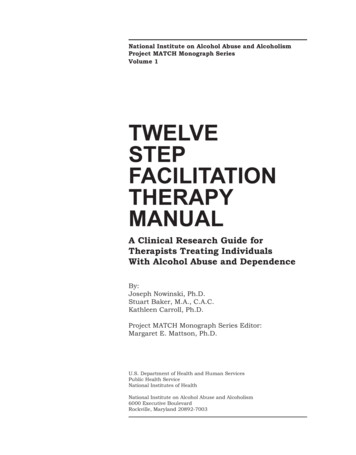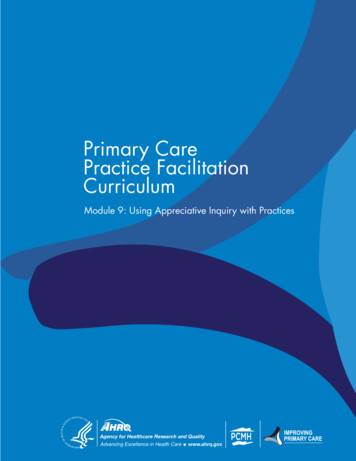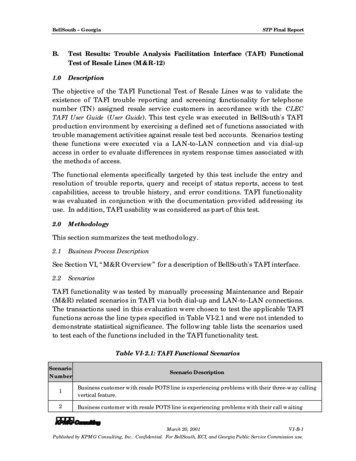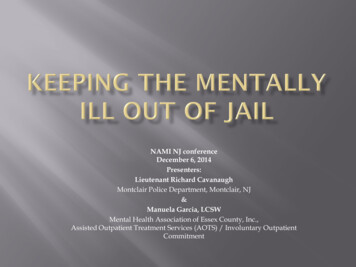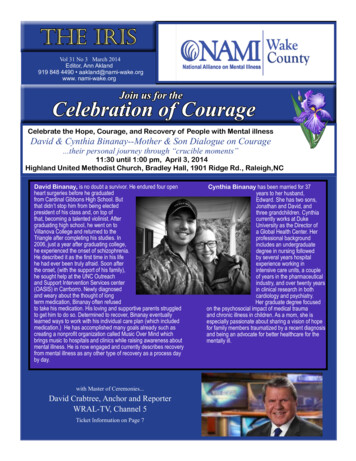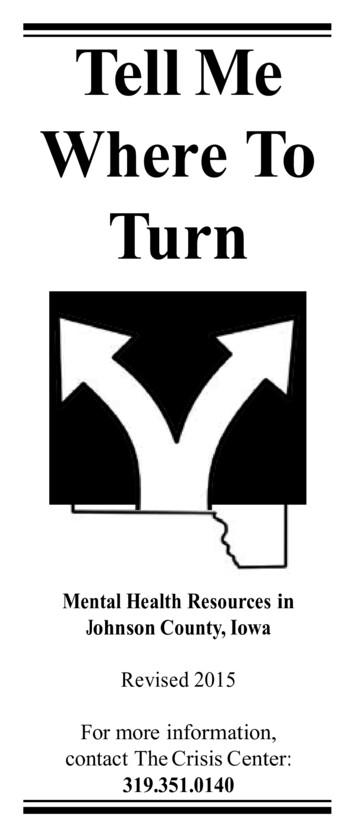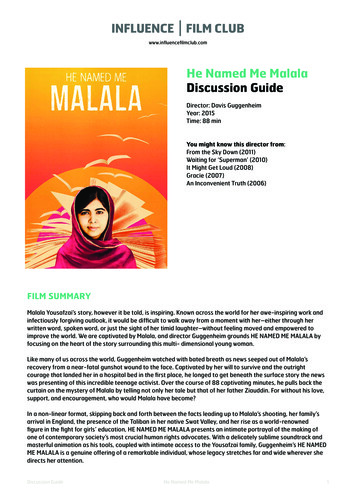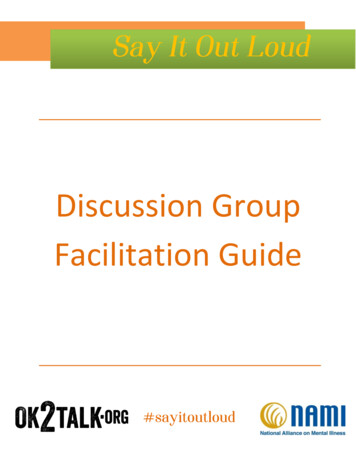
Transcription
Discussion GroupFacilitation Guide
Say it Out Loud—Discussion Group Guide 2014 by NAMI, the National Alliance on Mental IllnessWritten by Darcy Gruttadaro and Emily CeplaDesigned by Emily CeplaThis document was produced with partial support from the Child, Adolescent and Family Branch, Centerfor Mental Health Services (CMHS), Substance Abuse and Mental Health Services Administration(SAMHSA), U.S. Department of Health and Human Services (HHS) through Contract No.HHSS280201000001C with the American Institutes for Research. The content of this publication does notnecessarily reflect the views, opinions, or policies of SAMHSA or HHS.NAMI, the National Alliance on Mental Illness, is the nation’s largest grassroots mental health organizationdedicated to building better lives for the millions of Americans affected by mental illness. NAMI advocatesfor access to services, treatment, supports and research and is steadfast in its commitment to raisingawareness and building a community of hope for all of those in need.National Alliance on Mental Illness (NAMI)3803 N. Fairfax Dr., Suite 100Arlington, VA 22203NAMI Helpline: 1 (800) 950-NAMI (6264)Twitter: NAMICommunicateFacebook: .org
Thank you for taking the first step in raising mental health awareness with the youth that youwork with. Your commitment to starting a dialogue about mental health makes a difference aswe raise awareness and make it okay to talk about.This guide will provide you with everything you need to lead a successful group discussion withthe youth group!Who are We?NAMI is the nation's largest grassroots mental health organization dedicated to building betterlives for the millions of Americans affected by mental illness. NAMI advocates for access toservices, treatment, supports and research and is steadfast in its commitment to raisingawareness and building a community of hope for all those in need. To learn more about NAMI,visit www.nami.org.Background InformationMental health issues are common among youth. 50 percent of lifetime cases of mental healthconditions begin by age 14, with 75 percent emerging by age 24. 1 in 5 teens will experience amental health issue at some point in their lives. Yet, more than half of youth experiencing amental health condition are not getting services or supports. Concern about negativeperceptions and fear are major factors in youth not seeking help.Raising awareness by sharing information and starting conversations about mental health arekey in reducing these perceptions and increasing the likelihood that teens will seek mentalhealth services and supports when they need it. This guide and the facilitated presentation withit include everything you need to fully prepare for leading a discussion with teens about mentalhealth.For this project, targeted for 14-18 year olds, we worked with a film maker in developing ashort film, which runs about 5 minutes, that features the 10 common warning signs of mentalhealth conditions and three youth talking about living with a mental health condition and why itis important to talk about it. The film is a terrific way to jump start a conversation with teensand, if they are experiencing a mental health condition or see the signs in a friend, to encouragethem to not be afraid to talk about it and to Say it Out Loud.3
Where Should I Start?This guide walks you through the steps for leading a successful discussion with youth aboutmental health. The USB drive that you received contains everything you need for a successfuldiscussion, including the following: An informational presentation with more detailed background information aboutmental health conditions in youth. This guide that provides recommendations on leading the group discussion anddiscussion questions to break the ice. A short film to share with youth to get a conversation about mental health started. Fact sheets to share with youth and others who may be interested.Let’s get started! Watch our educational presentation titled Presentation for Adults to getprepared for your discussion group and then come back to this guide for the next steps.Preparing for DiscussionBefore leading the Say it Out Loud youth discussion group, here are things you can do toprepare and to help ensure that it is a success: Read this guide in its entirety. It gives you everything you need to know to be prepared. Have a conversation with your organization about the discussion you will be having.Determine next steps if youth seek help or support. Review the resource sheet attached to this guide. The resources listed provide valuableinformation to youth and their families about services and supports available in thecommunity. Set the discussion agenda. Your youth group discussion should be no more than an hourand an agenda helps you to stay on time and topic. A sample agenda is included at theend of this guide. Print the sheet of celebrities living with mental health conditions found at the end of theguide. This will be helpful for your group discussion. View the short film designed to get the conversation started with teens. Have the filmloaded onto a computer or TV that you will be using for the group discussion. The filmcan be found on the USB drive. Test your connection and equipment before you holdthe group discussion to be sure that everything goes smoothly on the day of yourdiscussion.4
Facilitating Discussion GroupsNow that you’ve watched the presentation and the film and have everything ready, it’s time tolead the youth in a facilitated discussion. Although we went through some of these tips in thepresentation, it helps to have the tips in front of you during the discussion.Remember to always treat the youth in the discussion with respect. Listen to what they have tosay. For some, this may be the first time they have talked about mental health and it may be abit awkward for them. That’s okay. They are likely stepping out of their comfort zones, which isnot always easy.Discussion ground rules. Before showing the short film, lay some ground rules. We suggest thefollowing: Everyone gets a chance to talk. Do not talk over each other—only one person can talk at a time. Personal attacks, making fun of comments shared by others or negative commentsare not allowed. This is a safe place to share information, but there are certain things that should notand will not be kept secret including information about serious self-harm. If thiscomes up, we will have an immediate private conversation and it will require me toinvolve another safe adult to protect you.Say it Out Loud Short FilmAt this point, you should show the Say it Out Loud film with the ten common warning signs ofmental health conditions and why speaking up is important. You can access the film on the USBdrive. You should have this already loaded on the computer that you are using during thediscussion so that you can play the film after your short introduction and sharing of the groundrules.The film consists of two parts: First is a short visual depiction of the ten common warning signs of a mental healthcondition. This part of the film shows youth what the warning signs might actually looklike in someone experiencing them. The second part features three youth talking about their personal experiences livingwith mental health conditions—what it felt like, how they got help and why it’simportant to speak up about them.5
Introduce the film by telling the youth what they are going to see and reminding them thatthere will be a discussion afterwards. You could say something like:Thanks for being here today. I’m really excited to talk to you about mental health andwhy it’s important. Before we start our conversation, I’m going to show you this shortfilm about the ten common warning signs of a mental health condition and whyspeaking up about experiencing these signs is important. The warning signs may seem alittle heavy, but what you are going to see is the reality for many people living withmental health conditions. You’ll also see three youth who have experienced these signsand now lead happy, successful lives.Discussion QuestionsAfter you have shown the film, you can open a discussion with the group. Below is a list ofdiscussion questions that will help get the conversation going. Feel free to use all or some ofthese or to come up with your own questions.1. What are your general reactions to what you just saw?2. What did you think about the warning signs? Were there any that surprised you?3. What would be your response to seeing these signs in a friend or family member?4. Do you think that helping someone experiencing these signs can help both of you?How?5. How can we make it easier to talk about mental health?6. What information do you think is important for adults to know about youth who may beexperiencing a mental health condition?7. How can we get more youth involved in talking about mental health?8. Can you name anyone famous—like celebrities, athletes, historical figures—who livewith mental health conditions?a. After they answer, hold up attached picture of celebrities to show them that thenumber is higher than they might think.Thank the youth for participating in this discussion and ask if there are any final thoughts. Passout the fact sheets included on the USB drive along with the resource sheet if you made one.Assure them that you and other trusted adults in your organization are there if they need totalk and that help is available if they or someone they know is experiencing the signs of amental health condition.6It may take a while for the youth to warm up to the idea of talking aboutmental health. Do not be discouraged if you do not have full participationduring your discussion. The youth are listening and are gaining valuableknowledge whether they participate or not.
Congratulations!You have just done your part to raise awareness about mental health conditions and informyouth about the options available to them should they need it. You have made a difference inthe lives of the youth affiliated with your organization and should feel good about yourcontribution. Congratulations on a job well done!One-on-One Conversations about Mental Health Conditions, Drug and AlcoholUse or SuicideYou may find that after the facilitated discussion, one or more of the youth want to talk to you.Whether they approached you individually or you noticed a teen in the discussion that seemedexceptionally uncomfortable or you just got a feeling about, consider engaging that youth in aprivate conversation.Remember, if a youth is coming to you, it means that they trust you and value your opinion. Besure to listen to what the youth has to say and reaffirm his or her feelings. Let them know thatyou are there to help and to connect them with services and supports in their communityUse one of the following plans to determine the proper steps to take to manage the situation:If you’ve talked to the teen and he or she is experiencing signs of a mental health condition:1. Remind the youth that you are there for them and are happy to help.2. Inform the youth that there is help available—therapists, psychiatrists andpediatricians are all there to help them feel better.3. Have the child identify one safe adult that you can reach out to. If they are hesitant,say “I know you’re unsure, but trust me. It’s the right thing to do at this time. It canreally help.” It is important to get another adult involved as early on in the process aspossible and there are professionals out there that understand what you are goingthrough and how best to help. Ask the teen if you can share the information with theirparent or caregiver. If they say no, then ask for another trusted adult who can help,perhaps another adult family member, a teacher, a coach or someone else. Let themknow it is important to seek help because without help the condition can get worse.7
4. Reach out to the safe adult identified by the teen and share what you’ve heard andoffer suggestions on where to turn—a therapist in the community, pediatrician, schoolcounselor, etc. The resource sheet that you developed with your organization will helpwith this.5. Offer the teen support. Remind them that they are not alone and that help isavailable.If a teen shares that he or she is experiencing suicidal thoughts or behaviors:1. Take any talk of suicide seriously. If a teen approaches you and shares suicidalthoughts, let the teen know that you are glad they have shared this information andreassure him or her that you can help and he or she is not alone.2. Provide reassurance. Let the teen know that there is help available and that you andothers care and want to help.3. Use your judgment. If the teen has suicidal thoughts, a specific suicide plan andseems intent on ending his or her life, get help immediately by calling 911 or theNational Suicide Lifeline at (800) 273-TALK (8255).4. Contact a parent or other trusted adult. If a teen shares suicidal thoughts with you,let him or her know that you cannot keep that a secret and that you need to contacta parent or trusted adult and ask who you should reach out to. Wait with the teenuntil the trusted adult arrives. Do not leave a teen who may be suicidal alone.5. Share the resource sheet. When the trusted adult arrives, share the resource sheetand recommend that they immediately seek mental health care for the teen.6. Share information about the encounter with others and document it. Let otherswithin your organization know that you had that conversation with a member of theyouth group and document how you handled it.You may also want to work with your organization to determine protocol in these types ofsituations before you begin your discussion. It is possible that a system is already in place toaddress these issues and that you can follow the determined steps.Remember, if anyone is in imminent danger of harm, call 911.For a teen perspective on suicide and how to talk to a
I’m really excited to talk to you about mental health and why it’s important. Before we start our conversation, I’m going to show you this short film about the ten common warning signs of a mental health condition and why speaking up about experiencing these signs is important. The warning signs may seem a little heavy, but what you are going to see is the reality for many people living .
